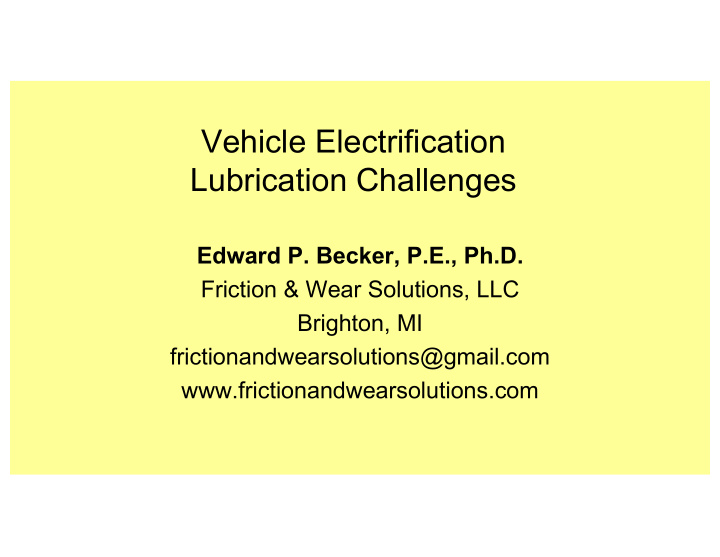



Vehicle Electrification Lubrication Challenges Edward P. Becker, P.E., Ph.D. Friction & Wear Solutions, LLC Brighton, MI frictionandwearsolutions@gmail.com www.frictionandwearsolutions.com
“Research engineers are now at work seeking new and satisfactory fuels which can be obtained, at a reasonable cost, to take the place of our rapidly decreasing supply of petroleum, from which gasoline is distilled.” --Wright, J. C. and F. C. Smith, Automotive Construction and Operation , J. Wiley & Sons, Inc., New York, 1924
Industry Drivers • CO 2 Emissions • Fuel Economy • Active Safety • Accident avoidance CO 2 Requirements – U.S. vs. Europe vs. Australia • Driver independent braking, steering and braking • Passive Safety • Occupant protection • Exterior energy absorption • Interior energy absorption U.S. MPG Requirements http://www.climatechangeauthority.gov.au/reviews/light-vehicle-emissions-standards-australia/light-vehicle-emissions- standards%E2%80%94setting-right https://www.vox.com/cards/obama-climate-plan/what-are-u-s-fuel-efficiency- standards-for-cars-and-trucks
Three Phases of Powertrain Evolution +2 to +3% FE increase > +12% FE increase after 2025 +5% to +12% FE increase 72 lotuscars.com/engineering Slide Courtesy Of Lotus Engineering
ICE Vs. EV Global Fleet Projections • China, the U.S. and Europe will make up over 60% of the global EV market in 2040 1 • Battery electric vehicles (BEV) leave plug-in hybrid vehicles (PHEV) behind beginning in 2025 1 1. https://data.bloomberglp.com/bnef/sites/14/2017/07/BNEF_EVO_2017_Execut iveSummary.pdf
Tesla Roadster Charging
1914 Detroit Electric
c. 1913 Rausch & Lang Campbell House, Spokane, WA
Gasoline Engine
Diesel Engine
Electric Motor
Tesla Electric Motor (single speed gearbox)
Chevy Volt Electric Motor
Nissan Leaf Motor
Protean In-Wheel Motor
Batteries for EVs • Lead-acid batteries were used for the earliest EVs through the GM EV-1 (1999) – Limited range – High cost – Long charging time • Lithium-ion batteries are now used – Higher cost – Better range – Faster charging
Fuel Cell (Schematic)
Equinox Fuel Cell Vehicle
H 2 from water + Al alloy
SURUS (Silent Utility Rover Universal Superstructure)
Grease Requirements for Hybrid and Electric Vehicles • Most greased structures remain the same – Wheels – Closures – Sealed motors • Accessories (power steering, AC) use greased, sealed for life, electric motors
Lubrication Challenges for Hybrid Electric Vehicles • Both an internal combustion engine and electric motors provide propulsion • Electric motors are typically lubricated by conventional transmission fluid • ICE requires engine oil, but the engine experiences many more stop-start cycles and lower overall operating temperature than dedicated ICE vehicles – Water and fuel dilution – Additive activation
Lubrication Challenges for Pure Electric Vehicles • EVs with a gearbox use transmission fluid to lubricate the motor bearings – May be torque-limited due to gear wear • In-Wheel electric motors typically used sealed roller bearings • Grease is added only at assembly • Temperature range in excess of -40°C to +40°C
Future of Grease for Electric Vehicles • Compatibility with new materials – Copper wires and windings – Advanced polymers • High and low temperatures – Vehicles must operate at -40°C – Electric motors generate heat • Permanent magnet motors are temperature limited • Induction motors can experience temperature excursions • Electric current and magnetic field compatible • High speed and torque input to reduction gears
Recommend
More recommend